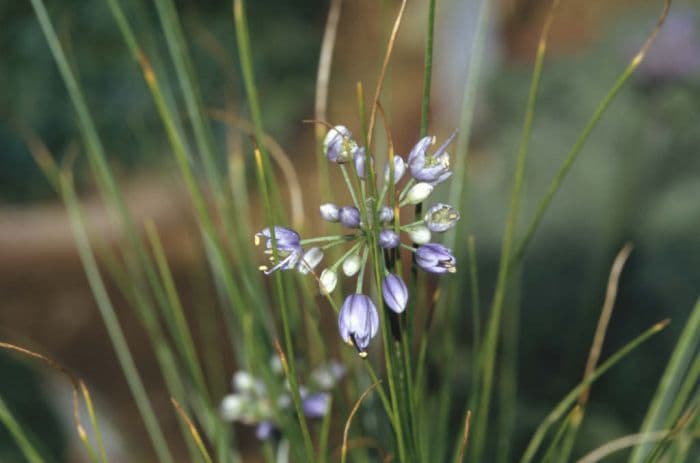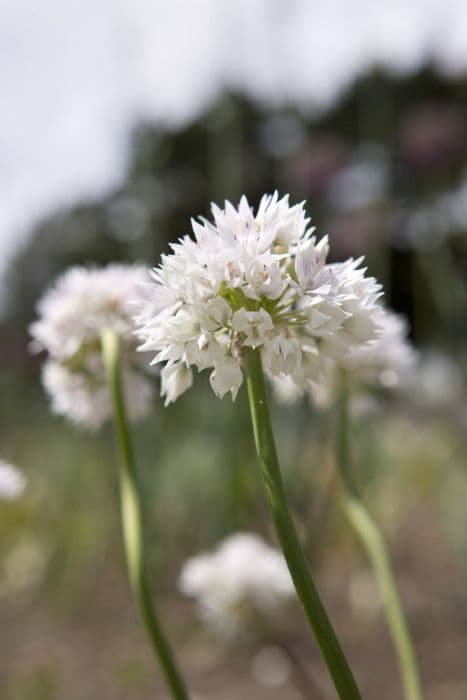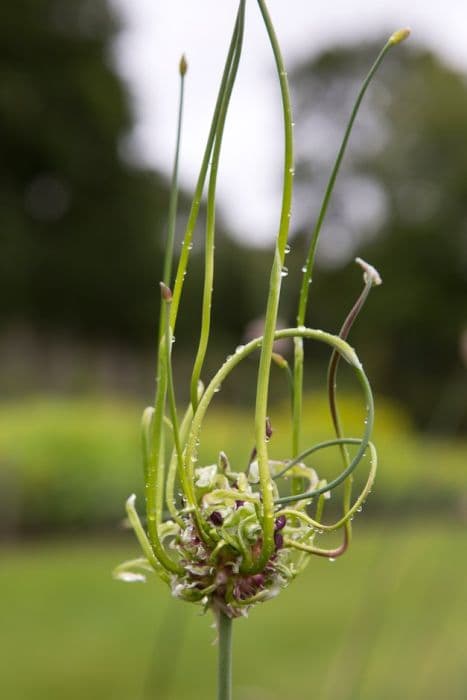Blue Onion Allium cyaneum

ABOUT
Allium cyaneum, commonly known as Blue Onion or Cyan Onion, displays a distinctive appearance that reflects its ornamental charm. This plant features a clump-forming habit, which means that it tends to grow in grouped clusters, adding density to its overall look. The foliage comprises slender, elongated leaves that radiate from the base with a flexibility that leads to a gentle arch. These leaves are typically a shade of rich green, adding a lush, vibrant backdrop for the more dramatic floral elements of the plant. The most striking feature of Blue Onion is its inflorescence—a cluster of small, star-shaped flowers that form a globular or spherical head atop a sturdy, upright stem. These blooms boast a vivid blue to purplish color, hence the name 'Cyan Onion'. The flowers' arrangement in the cluster is compact, creating a dense sphere that appears like a jewel held aloft. As these flowers mature, they retain their colorful allure, creating an extended period of visual interest. The contrast between the brightly colored flower heads and the green foliage is visually striking, making Blue Onion a sought-after addition to gardens for those seeking to inject a splash of blue into their plant palette. Despite its colorful flowers and attractive foliage, its non-blooming visual aspects are understated, serving primarily as a foil to the dramatic blossoms that appear during the blooming season. The plant holds its ornamental value from sprouting to bloom, leaving lasting impressions upon onlookers fortunate enough to witness its beauty in situ.
About this plant
 Names
NamesFamily
Amaryllidaceae
Synonyms
Blue Onion, Cyan Allium
Common names
Allium cyaneum.
 Toxicity
ToxicityTo humans
Allium cyaneum, commonly referred to as blue onion, is not widely known for toxicity to humans. Typically, members of the Allium genus, which includes onions, garlic, and chives, contain compounds that can be irritating to the gastrointestinal system when consumed in large quantities. However, there's no well-documented case of poisoning from Allium cyaneum specifically. People with sensitivity to other Allium species may experience similar symptoms which can include nausea, vomiting, and diarrhea if they ingest a significant amount of blue onion.
To pets
Blue onion, or Allium cyaneum, can be toxic to pets, especially cats and dogs. All members of the Allium family contain compounds that can cause oxidative damage to red blood cells leading to hemolytic anemia in pets. Symptoms of poisoning may include vomiting, diarrhea, abdominal pain, weakness, and lethargy. In severe cases, ingestion can lead to hemolytic anemia, methemoglobinemia, or even death. If a pet consumes any part of a blue onion plant, it is important to seek veterinary care promptly.
 Characteristics
CharacteristicsLife cycle
Perennials
Foliage type
Deciduous
Color of leaves
Green
Flower color
Blue
Height
1 foot (30 centimeters)
Spread
1 foot (30 centimeters)
Plant type
Bulb
Hardiness zones
4
Native area
China
Benefits
 General Benefits
General Benefits- Culinary Uses: Allium cyaneum, commonly known as blue onion, is used in cooking for its unique flavor, often added to dishes for seasoning.
- Ornamental Value: Blue onion produces attractive flowers that can add visual interest to gardens and landscapes.
- Pollinator Attraction: The flowers of the blue onion attract bees and other pollinators, supporting local ecosystems.
- Soil Improvement: Like other Allium species, blue onion can contribute to soil health by improving its structure and nutrient content.
- Companion Planting: Blue onion can be used in companion planting to deter pests from more vulnerable crops.
- Low Maintenance: This plant generally requires minimal care, making it suitable for gardeners of all skill levels.
- Drought Resistance: Blue onion is fairly drought-resistant once established, conserving water resources.
 Medical Properties
Medical Properties- Not recognized for medicinal use: Allium cyaneum, commonly known as Blue Onion, does not have well-documented or widely recognized medicinal properties.
 Air-purifying Qualities
Air-purifying QualitiesThis plant is not specifically known for air purifying qualities.
 Other Uses
Other Uses- Allium cyaneum, commonly known as Chinese onion, can be used as a natural dye, with the plant producing a range of blue and purple hues that can color fabrics and textiles.
- In companion planting, Chinese onion may help to repel certain insects or attract beneficial pollinators when planted near vegetables and fruits in a garden.
- The plant's strong scent could serve as a natural rodent repellent in barns and storage areas where food is kept.
- Chinese onion could be utilized in ornamental garden designs due to its attractive blue flowers, providing aesthetic value to landscapes.
- The sturdy, hollow stems of the Chinese onion may be used in crafts as a part of homemade plant supports or as natural straws in floral arrangements.
- With their characteristic smell, the leaves of Chinese onion could be incorporated into potpourris to create a unique, onion-like aroma profile for the home.
- The seeds of Chinese onion might be used in bird feed mixes to offer a varied diet to seed-eating birds in the backyard.
- Culinary enthusiasts might experiment with the plant's edible parts to create color-changing cocktails, taking advantage of the natural blue pigment's reaction to pH changes.
- As part of environmental education programs, Chinese onion could serve as a subject for studying plant biodiversity and the importance of preserving rare species in their native habitats.
- When dried, the beautiful blue blossoms of Chinese onion could be used to make bookmarks, greeting cards, or other paper crafts, adding a touch of nature to personal gifts.
Interesting Facts
 Feng Shui
Feng ShuiThe Blue-flowered Onion is not used in Feng Shui practice.
 Zodiac Sign Compitability
Zodiac Sign CompitabilityThe Blue-flowered Onion is not used in astrology practice.
 Plant Symbolism
Plant Symbolism- Perseverance: Allium cyaneum, also known as blue globe onion, often symbolizes perseverance due to its ability to thrive in harsh conditions and its resilient nature.
- Unity: The spherical shape of the blue globe onion's blooms represents unity and togetherness, often used to convey a sense of community or teamwork.
- Good Fortune: In some cultures, the blue globe onion is thought to bring good luck, making it a common gift for new ventures or as a token of well-wishes.
- Protection: Similar to other members of the Allium family, blue globe onions are believed to have protective properties, warding off evil and negativity.
- Healing: Given its medicinal properties, the blue globe onion can signify healing and recovery, both physical and emotional.
 Water
WaterThe Blue Ornamental Onion should be watered thoroughly, allowing the water to reach deep into the soil, which encourages deeper root growth. On average, you should water the plant once a week with approximately 1 gallon of water. However, during the active growth season in spring and summer, the watering frequency may need to increase, especially if the weather is particularly hot or dry. It's essential to ensure the soil is moist but not waterlogged, as the Blue Ornamental Onion does not like standing water. Always check the top inch of soil for dryness before watering again.
 Light
LightThe Blue Ornamental Onion thrives best in full sunlight to partial shade. Ideal locations would be where the plant can receive at least six hours of direct sunlight daily. However, in areas with extremely hot summers, providing some afternoon shade can help protect the plant from excessive heat that can potentially harm it. Avoid deep shade as it will not allow the Blue Ornamental Onion to flourish properly.
 Temperature
TemperatureThe Blue Ornamental Onion prefers a temperature range of 55°F to 75°F for optimal growth. While it can tolerate temperatures as low as 20°F, it is important to avoid prolonged exposure to temperatures below this threshold to prevent damage. Similarly, temperatures significantly above 75°F may stress the plant, so providing shade during the hottest parts of the day can help mitigate heat stress.
 Pruning
PruningPruning the Blue Ornamental Onion involves deadheading spent flowers to encourage more blooms and to prevent the plant from self-seeding too prolifically. This is best done in late summer or fall, after the flowers have faded. Prune the flower stalks down to the base of the plant to maintain a tidy appearance. Regular pruning isn't necessary, but occasional removal of old or yellowed leaves can keep the plant looking its best.
 Cleaning
CleaningNot needed
 Soil
SoilBlue onion (Allium cyaneum) prefers well-draining soil with a mixture of loam, sand, and compost. The soil pH should be slightly acidic to neutral, ranging from 6.0 to 7.0, to provide optimal growing conditions and nutrient absorption.
 Repotting
RepottingBlue onion (Allium cyaneum) typically doesn't require frequent repotting and can be repotted every 2-3 years or when the bulbs appear crowded in their current container.
 Humidity & Misting
Humidity & MistingBlue onion (Allium cyaneum) thrives in average room humidity levels. It does not require high humidity and can adapt to the typical indoor environment.
 Suitable locations
Suitable locationsIndoor
Place blue onion in bright, indirect light indoors.
Outdoor
Plant blue onion in full sun to partial shade outdoors.
Hardiness zone
4-9 USDA
 Life cycle
Life cycleAllium cyaneum, commonly known as blue-flowered onion, begins its life cycle when a seed germinates in the soil, requiring adequate moisture and a certain range of temperatures. Upon germination, a small bulb forms and roots start to grow downwards as shoots emerge upwards towards the light. The plant then enters a vegetative stage, developing long, slender leaves and establishing a strong root system. After a period of vegetative growth, the blue-flowered onion transitions to the reproductive stage, wherein it produces tall stems topped with clusters of distinctive blue to purple flowers that attract pollinators. Following pollination, the flowers give way to seed capsules that mature, eventually releasing new seeds into the surrounding environment to propagate the next generation. Finally, the plant goes into dormancy, especially in regions with colder climates, with the bulb lying dormant underground until the next suitable growth period.
 Propogation
PropogationPropogation time
Spring to early summer
Propogation: The most popular method of propagating Allium cyaneum, commonly referred to as Blue Onion, is through division of its bulbs. This is typically done in the autumn after the foliage has died back. Gardeners carefully dig up the mature plants, taking care to avoid damage to the bulbs and roots. They then gently separate the clump into individual bulbs, each of which should have a portion of the root system attached. Ideally, division should result in bulbs that are about 1 to 2 inches (2.5 to 5 centimeters) in diameter. These newly separated bulbs can be immediately replanted in well-draining soil at a depth approximately three times the height of the bulb with the pointy end facing upwards. The bulbs should be spaced about 4 to 6 inches (10 to 15 centimeters) apart to ensure ample growing space.








